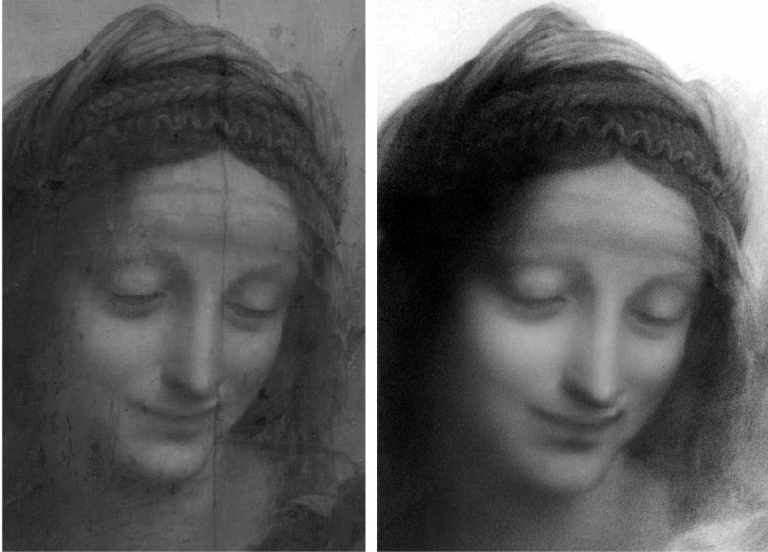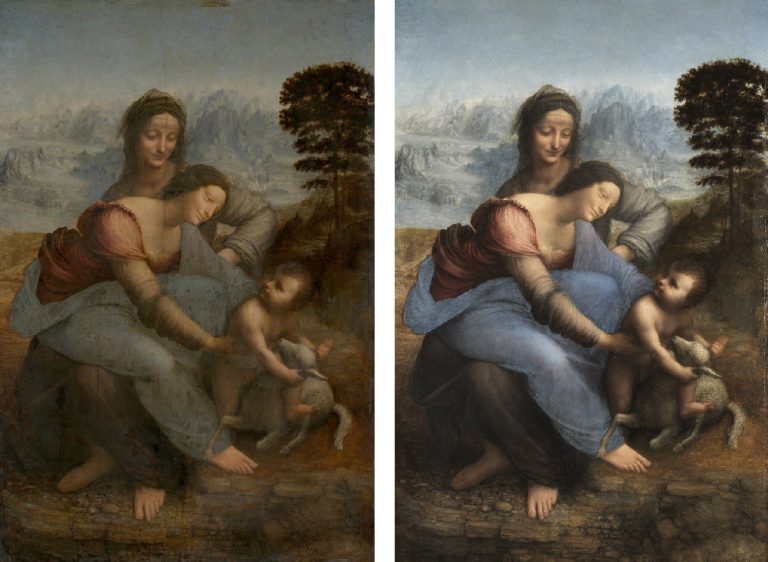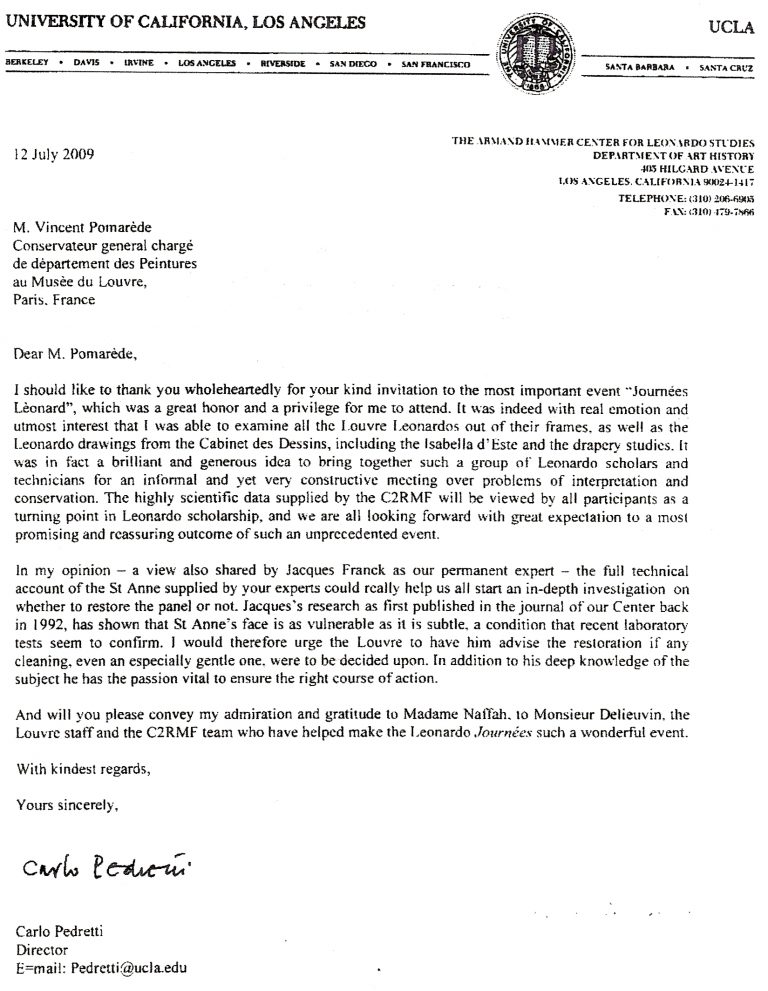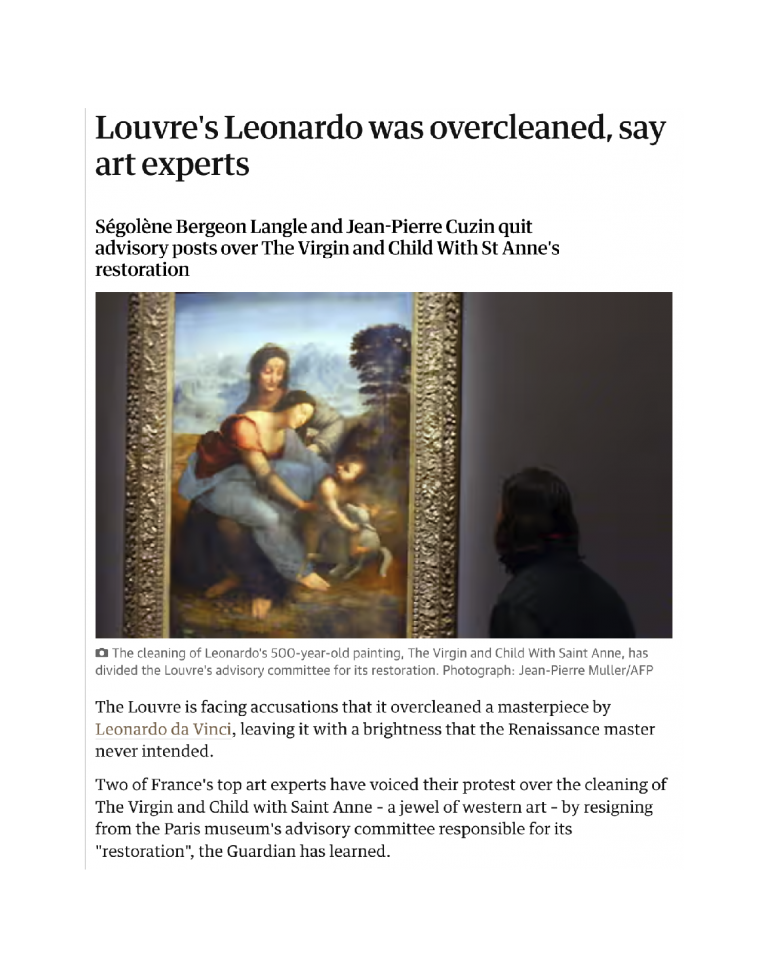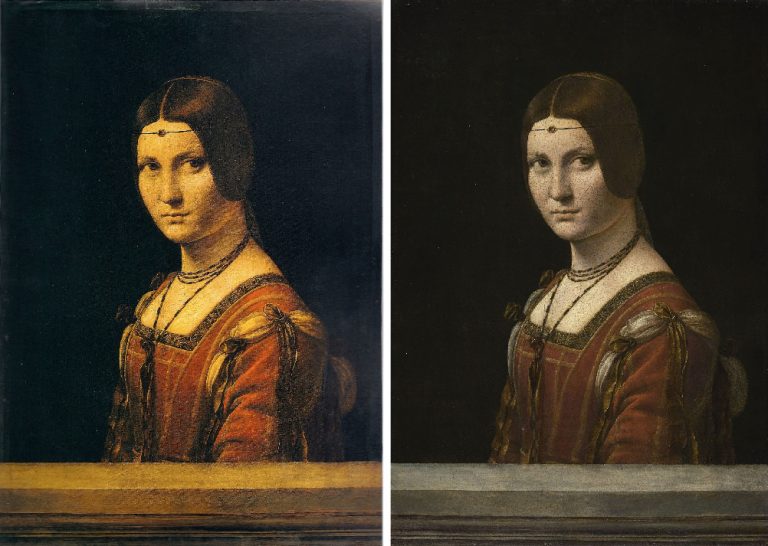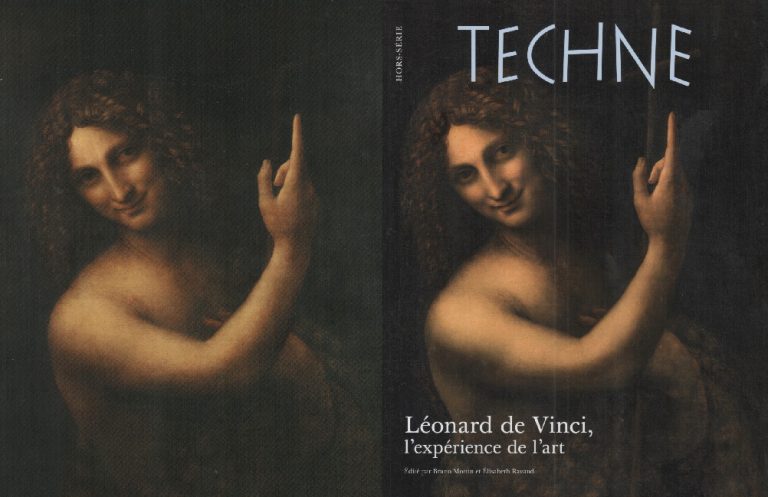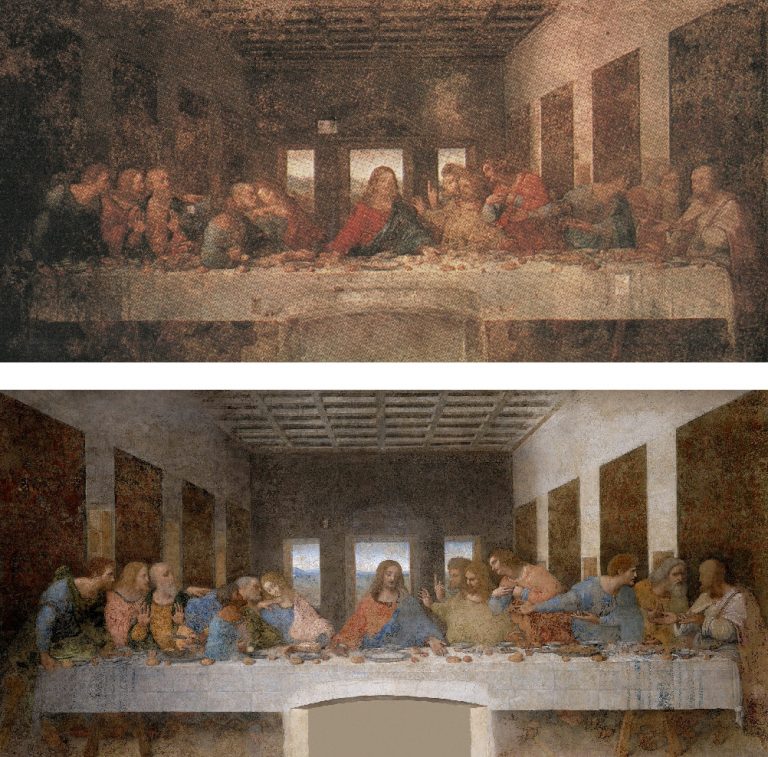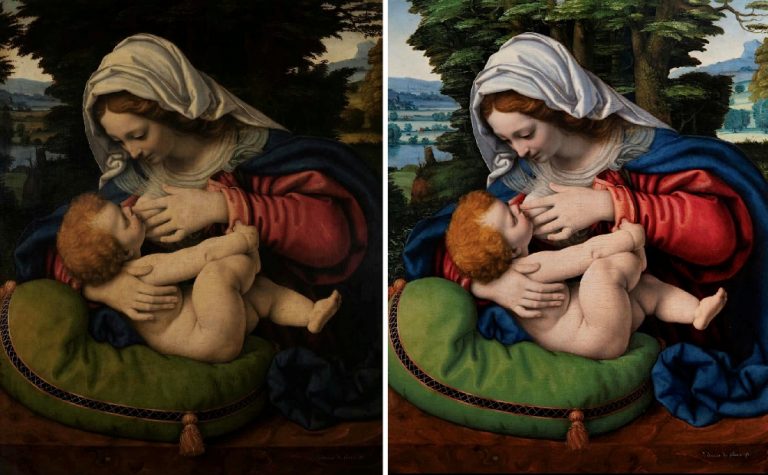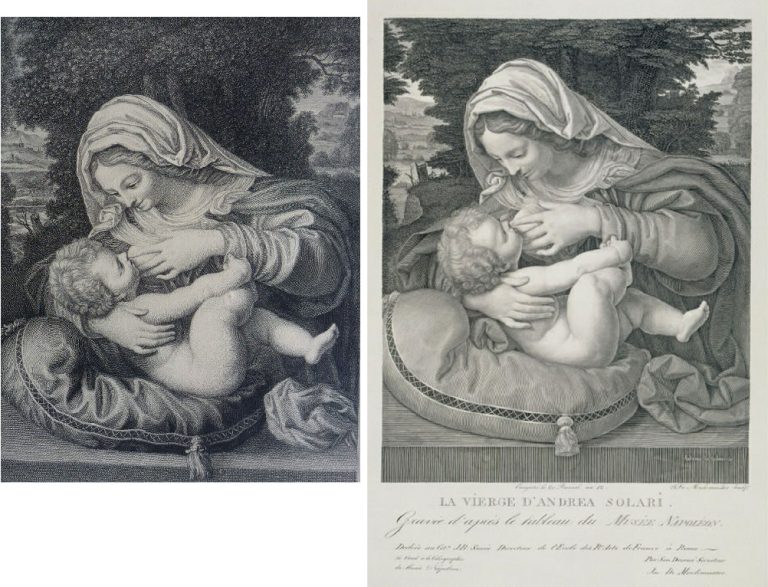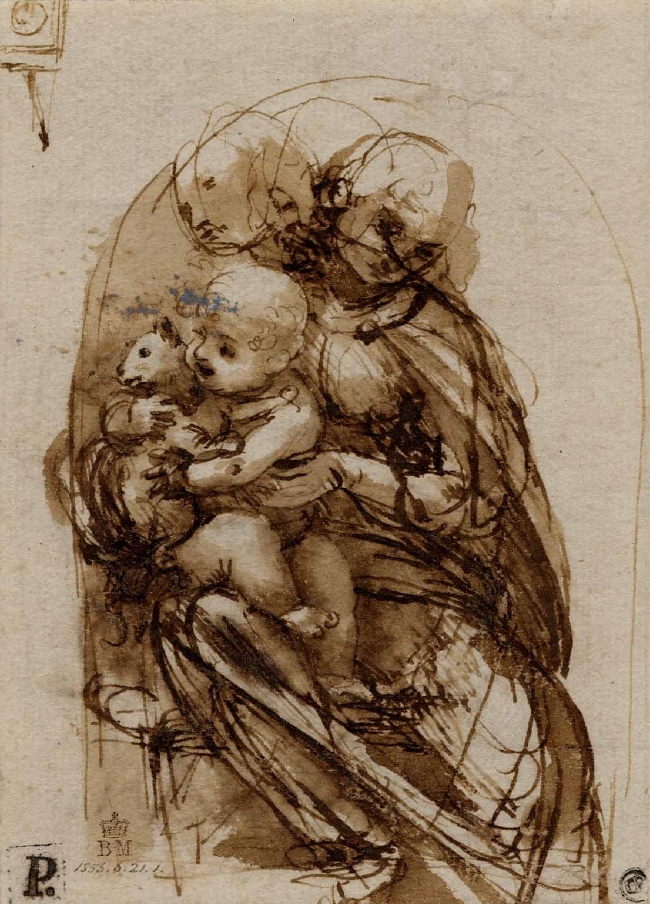A Notice of Alarm from Leonardo Specialist, Jacques Franck:
Dear Leonardo colleagues, dear Leonardo lovers,
I have recently learnt from first-hand (external + in-house) sources, that the Musée du Louvre intends to clean the Mona Lisa on the occasion of the masterpiece’s forthcoming move to a new subterranean room in the course of the planned expansion/renovation of the Museum which is to end by 2031.
The existence of such a project surprises me for the following reasons:
1) The panel is in a rare and exceptional condition for a work aged 500 years, a fact that I was able to check in 2003, 2004, 2005, 2009 and 2012 when I saw it out of its frame with the Louvre curators and scientists in the Salle des États where it is exhibited today. Bar the yellowed varnish which is skilfully neutralized by the specific lighting set inside the icon’s bullet-proof vitrine, the paint layer is intact: in other words, as anyone can see in the Louvre itself before the work; in documentary movies; or in photographs released by the Museum, the Mona Lisa still looks gorgeous and, obviously, doesn’t need any cleaning.
Above, Fig. 1: Leonardo da Vinci, the Mona Lisa, Paris, Musée du Louvre.
2) Following a large-scale press investigation about a possible cleaning of Leonardo’s enigmatic portrait published jointly by Il Giornale dell’arte, Le Journal des Arts and The Art Newspaper in 1998, Jean-Pierre Cuzin, the then Head of Paintings at the Louvre, had stated: “There is no question of undertaking conservation, of whatever nature, of the “Gioconda”. To be sure, the old varnishes make the picture yellow and affect its impact somewhat; but the varnish is very even, with no disturbing blotches. Besides, the work, which is painted on panel, is in superb condition and is regularly checked. Do I have to remind people that this painting is universally famous in its present state? I distrust on principle any conservation that might be considered “sensational” to the extent that it is not made necessary by the condition of the work itself” (The Art Newspaper, n° 84, September 1998 – see Fig. 2 below). Eighteen years later, on February 16, 2016, the new Head of Paintings, Sébastien Allard, expressed the same, unchanged position, in an email sent to me while confirmed to the press: “I learn of your worries following some statements spread in the press, whereby it was suggested that I intend to clean the Mona Lisa. But be reassured now: I have no intention whatsoever to proceed with the cleaning of the Mona Lisa. I have mentioned it very clearly during the press conference. The Louvre’s press service (which is copied into this email) has informed the concerned journalists accordingly” (author’s translation – and see note 1.)
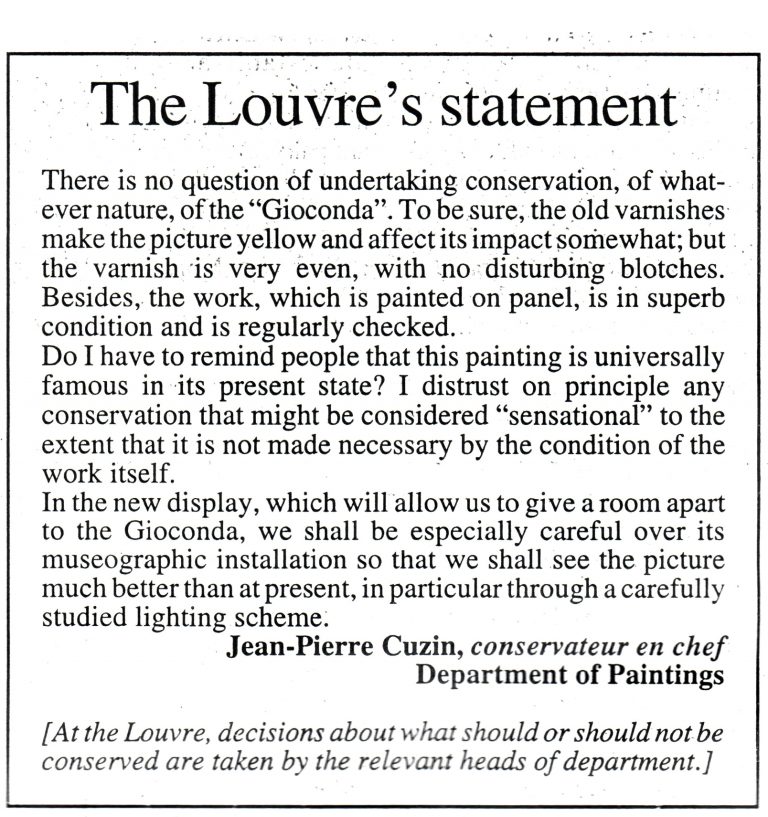
Above, Fig. 2: The Art Newspaper n° 84, September 1998, statement by Jean-Pierre Cuzin, then Head of Paintings at the Louvre
Given the preceding, I find it urgent to explain why, as a scholar and a Leonardo “critical copyist”, I think that the above cautious statements remain sound and pertinent. Many of you know that in 1993 I published an essay in Achademia Leonardi Vinci, vol. 6, titled “The Unrestorable Sfumato” which summarized my then thirty years-long research on Leonardo’s painting technique through the systematic, critical copy-work of his late paintings, namely, the Saint Anne and the Mona Lisa. This research was for me the way to “meet” Leonardo as an artist, to identify what belongs to him alone and, ipso facto, what doesn’t and, therefore, is unacquainted with his practice. The copies’ step by step confrontation with the original works were the experimental ground of this learning (see Fig. 3B below). As an academic trained painter, I had long suspected that the flesh technique used up to paroxysmal perfection in the Mona Lisa portrait had nothing to do with the traditional blending in of the tones, but something far more complex yet to be discovered. The result of my quest, ran through years of painstaking exercises – given Leonardo’s inaccessible genius -, has led me to formulate the theory of his complex blending technique well known to all of you now (see the attached bibliography). In addition, I am finishing a long-term research thesis for which I explored over twenty years huge amounts of historical documents and examined masses of laboratory tests results (including their scientific interpretation), with a view to check whether the latter supply or not data consistent with regard to traditional, well-informed studio practice and the inherent timeless artistic-technical gestures. This type of investigation has brought unexpected support to my insights and at the same time shown the astounding discrepancies that exist between the scientific approach to art and art in the real, a problem that scientists, connoisseurs and restorers are too often unaware of. Whatever the case, my theory about Leonardo’s sfumato technique employed in the Mona Lisa is now supported by both visual and scientific evidence (note 2). Regarding the latter publication, it is worth noting that the numerous superimposed veils of paint described by me in 1993 as an essential process in the making of my copies after Leonardo – the veils which I then thought were used in the Mona Lisa – would be detected in 2015 by Philippe Walter in the work’s flesh sections thanks to X-ray fluorescence spectroscopy (note 3). This considerable step forward is absolutely crucial in understanding the truly problematic nature of Leonardo’s late works in the event of any restoration. A fact sadly confirmed by what happened when the Louvre Leonardos were cleaned in the 2010-2016 conservation programme in which my expertise was involved as set out below (note 4).
Above, Fig. 3: A (left) Leonardo da Vinci, the Louvre Saint Anne (detail of head before cleaning); B (right) Jacques Franck, unfinished copy of A, c. 1986-1989 (author’s collection). Stage 1 of “critical copy work” (here in Caran d’Ache colour pencils: 3000 hours of work). Exercise intended for the author’s conservation students in 1983-1998: Such drawn copy/demonstrations are essential to prove that the restorer/copyist a) understands what he sees and b) can reproduce it. A more advanced stage of critical copying in oils involves experimenting with the technical gestures and the physical nature of the paint materials that are necessary to achieve the sfumato effects visible in the original. Such a step is necessary to ensure that the paint structure of the critical copy and that of the original match. It also helps to check whether a restoration hypothesis of the original work informed by material data observed in the “stage 2 copy” is relevant or not. Such a method proved successful: the author’s free copy in oils of the Saint Anne in the Burlington House cartoon (National Gallery, inv. 6337) shows a close analogy in X-rays with the X-radiographs of the Louvre Saint Anne and the Mona Lisa (cf. Franck, 2017, p. 18-21, figs. 5-9, and note 3 below).
The disappointing cleaning of the Saint Anne and of St John the Baptist
Above, Fig. 4: A (left) Leonardo da Vinci, the Louvre Saint Anne before cleaning; B (right), the Louvre Saint Anne after cleaning.
A – The Virgin and Child with Saint Anne (2010-2012). Long before the restoration project of the Saint Anne was decided I had warned the Louvre that Leonardo’s highly subtle technique using veils of paint in the flesh zones, made of “tinted varnishes”, required extreme caution, that is, thinning the obscured varnish down to 20 microns and not lower in Saint Anne’s head (which was cleaned last with 8 microns left only). Carlo Pedretti was instrumental in supporting my cautious position with Vincent Pomarède, who had succeeded Cuzin in 2003 as Head of Paintings (see Fig. 5 below and note 5). However, when the cleaning began it became clear that the paint surface was posing tricky problems in some sections, notably in the landscape, and more precisely in the brown rocky ground where the group stands.
Behind the Virgin’s back, the long rectilinear portion which separates the brown terrain and the frozen blueish lakes and mountains was first thought by some members of the scientific committee to be a large repaint (and so likely to be removed) until its material was analyzed by the Louvre’s lab and found “compatible with 16th century paint ingredients”. On the right hand-side of the composition, the same terrain (notably in the small space located inside Saint Anne’s bent left arm next to her body (unfortunately cleaned off in part – see Fig. 6 below) was suspected to be a late addition also because it appeared to be dissolved by cleaning solvents spontaneously.
That was the case as well with the hillock supporting the tree, its lower part, and, particularly, the roughed-out suckers around the trunk. A heated debate then arose among the committee as to whether the tree should be “purified” or not : it wasn’t accepted for two reasons : 1) the curator general Ségolène Bergeon Langle, said that an ancient paint’s solubility is no evidence that it isn’t original : some very old paints are proven dissolved by solvents at once despite the passing of time, 2) the copy of the Louvre Saint Anne by Raymond Balze (c. 1840) (Fig. 7 below) shows to some extent that today’s image of the painting existed 170 years ago already. Then, making the intervention even more difficult, another problem emerged, casting a dramatic atmosphere over the project: at an advanced stage of the Child’s cleaning, what looked like a blanched (= opacified) varnish reappeared, visually awkward.
While a simple technical operation can help recover the lost transparency of such a varnish, the unusual typology of the presumed blanching made Bergeon Langle and me suspect that it was in fact an original brown glaze, yet faded and gone white, put by Leonardo to strengthen the flesh modelling in the shadows of Christ’s figure. In other words, we both considered that it should be kept and regenerated.
To make the story short, no serious attention was paid to our request (based on unconvincing tests results, the Louvre’s lab dismissed our views): the so-called conservation varnish was removed during the Summer of 2011 when the committee was on holiday. This radical removal made Bergeon Langle resign from the committee together with Jean-Pierre Cuzin (the former Head of Paintings) (Fig. 8); I didn’t quit, however, assuming that I could be of help until the completion of the work and finally ratified the overall project although feeling very uncomfortable about its outcome. Madame Bergeon Langle (both an art historian and a chemist) later published a number of essays about the case, explaining the frequent confusion between blanched varnishes and opacified glazes, in particular regarding some lakes used in the past, made of vegetal colourants that fade off while leaving the substratum on which they once were fixed (note 6).
Above, Fig. 5: Letter of 12 July 2009 from Prof. Carlo Pedretti, Director of the Armand Hammer for Leonardo Studies at UCLA, to Vincent Pomarède, Head of Paintings at the Musée du Louvre (author’s archives).
Above, Fig. 6: details of Fig. 4 showing the removed fragment of terrain at B (right) as compared with the uncleaned stage at A (left) – and, moreover, as had been copied in the 19th century work at Fig. 7 below.
Above, Fig. 7: Raymond Balze, copy of the Louvre Saint Anne, c. 1840.
Fig. 8: The Guardian, “Louvre’s Leonardo was overcleaned, say art experts”, by Dalya Alberge, Wed. 28 Dec. 2011, 16.45 CET.
B – I shall not speak at length about the cleaning of the Belle Ferronnière (see figs. 9 A and 9 B below) which came next (2014) despite the fact that when that of the Saint Anne was over in 2012, Vincent Pomarède told me the Louvre would not clean another Leonardo before “five years at least”. Pomarède was leaving the Paintings dpt. at the time while Allard was taking over. Yet, being still an essential member of the restoration committee, Vincent named me his personal adviser on the new cleaning project (note 7). The atmosphere soon became heavier than that of the Saint Anne four years earlier: from in-house sources I had heard that both the parapet and the black background in the portrait were put into question as possibly inauthentic by some members in the committee. Knowing that this was utterly wrong (in the Libro di Pittura, Leonardo recommends painting portraits of people seen from outside sitting before their home’s entrance door – or possibly, though not mentioned, a large window with a parapet), and, that way, viewed detached in chiaroscuro against a dark background. In a most regrettable email sent to Allard I strongly criticized the presence in the committee of “incompetent restorers researching vainly through cleaning the true Leonardo while removing the master’s original paint”. This of course got no response, but a few months later, i. e., on 13 November 2014, my advice to practice a very gentle thinning of the varnish only was given to Pomarède before the Belle Ferronnière in the Louvre’s conservation studio, the which advice was accepted in early 2015 by Allard, who chaired the committee. The portrait now looks marvelous, has undergone no drastic surgery, but the members of the committee whose views weren’t approved still believe that the Belle Ferronnière needs a lot more cleaning.
Above, Fig. 9: A (left) Leonardo de Vinci, the Belle Ferronnière before cleaning, Paris, Musée du Louvre; B (right), the Belle Ferronnière after cleaning.
Above, Fig. 10: A (left) Leonardo da Vinci, Saint John the Baptist before cleaning, Paris, Musée du Louvre; B (right), Saint John the Baptist after cleaning.
C – In 2016, the Louvre selected Regina Moreira to clean Saint John the Baptist, a project which Allard invited me to attend as an external adviser (note 8). I had sent him before many letters expressing my concerns and worries about any action to be done on the work because, knowing only too well the difficulties that had arisen during the last cleanings I feared that the complexity of the case to be treated would lead to failure. Regina’s skills, however, were high enough to let me expect the calming of my doubts in the end, so, when I saw her preliminary work, a very tactful thinning of the varnish, I felt relieved and didn’t think it necessary to come to the Museum’s conservation studio again before the final stage of her task. I therefore was most astonished and distressed when I saw the restored Saint John (above, Fig.10 A and B): the Saint’s head had doubtless been treated gently and his fur cloak retrieved in full, but the figure’ s strongly lit right arm and upper part of the torso were certainly quite a problem now.
As appears conspicuously on Fig. 10B, the soft transitional values between the darkest shadow and the highlights in the arm have gone off to such an extent that the overall shape of the limb seems a perfect arc of a circle, while the lighted flesh, now deprived of both “roundness” and volume, looks flat and lifeless when compared to the pre-cleaning stage. I swiftly enquired about the cause of the mishap and soon found it: at an early stage, the advisers seem to have imagined that pinkish flesh colours were underlying the golden hues of the paint surface and, contrary to my belief, that Leonardo did not create a candlelit scene, but one in daylight. In the search for fresher, pink flesh tones, which were never retrieved, the cleaning went deep enough to harm the mellow modelling of the arm and of the upper part of the chest. Despite my long explanatory letters sent to Allard, no notice had been taken of my previous warnings, apparently – and yet, Leonardo’s late technique is made of superimposed veils of tinted varnishes, each of a different colour, and organized in such a way that they interact optically together, thus building up the form’s volume and hues progressively and in synchrony. This optical system responds to the same principle as that used by photographers when they place on the camera transparent tinted filters, one over another, so as to get the coloured effect hoped for in their image (yellow over blue = green, etc.) The glazing process in art is quite similar given that glazes are transparent coats of paint. In 1590 Lomazzo precisely reported that Leonardo’s technique was made of superimposed veils of paint (“veli sopra veli”) one item of historical testimony whereby my own research is confirmed.
Regarding what happened with the Louvre Saint John the Baptist, it is easy to understand that the cleaning action weakened and flattened the arm’s volume: as it went deeper and deeper, the optical function of the veils making the 3D effect decreased proportionally to the quantity of veils removed. It might be interesting to hypothesize why the search for pink hues was undertaken. The Ambrosiana in Milan keeps a Saint John the Baptist in a landscape (Inv. 98 – see Fig. 11) attributed to Leonardo’s favourite pupil, Salai. We are faced here with a diurnal scene and a free interpretation of the Louvre composition, in which the flesh contains pink tints (obtained by mixing vermilion and white pigments). However, the correct reading of Leonardo’s esoteric Saint John isn’t accessible to all: it may mislead inattentive onlookers insofar as the dark background there is crucial in rendering both the figure and the surrounding space, to which it is immovably attached (see attached bibliography, Franck, 2021/2, caption of Fig. 9 B) in my Further thoughts II essay of 2021). Not really intelligible at first glance, that singularity alone makes the work a finished product of the highest perfection revealing that Leonardo never conceived a diurnal scene at the outset. Those who think otherwise believe that workshop products like the Ambrosiana Saint John reproduce intermediate stages in which Leonardo’s originals were before their ultimate completion, the Louvre Saint John included, but this theory is unlikely with regard to how the master’s bottega would function in his late years. Very absorbed in the service of great patrons and other princes of his time then, he was often kept away from the workshop for long months. It is therefore more realistic to consider that he encouraged the production of numerous variants (and copies) of his works in order to provide for the constant and remunerative activity of the staff in his absence.
Above, Fig. 11: Salai, Saint John the Baptist in a landscape, Milan, Pinacoteca Ambrosiana
Above, Fig. 12: A (top) Leonardo da Vinci, the Last Supper before cleaning, Milan, Refectory of Santa Maria delle Grazie; B (bottom) the Last Supper after cleaning.
Other recent Leonardo restorations
A – The Last Supper (1978-1997) – see Fig. 12 A & B above. In 1997, Carlo Pedretti published in ALV, vol. 10 (note 9), my views about the long cleaning of Leonardo’s Last Supper in Milan. Pinin Brambilla’s meticulous conservation work, devoted to cleaning off the heavy repaints added to the mural through the centuries, recovered about 20% of the injured masterpiece. The missing 80% is lost – which means that it has been replaced by the same percentage of inpainting, executed in “water-colourish” reversible pigments so that it cannot be confused visually with the retrieved original fragments when viewed at close observation. Given the resulting huge proportion of retouching, we are now faced with a very pale image in which are floating the magnificent details that have survived, but from a distance it looks ghostly and modernistic because the strong contrasts between light and shade once created by Leonardo have disappeared. The flatness thus created corresponds more to early 20th century aesthetic concepts than to late Quattrocento ones. The Milanese Soprintendenza had the possibility to display the remaining fragments like archaeological remains, as seen in antique sites and museums in Italy and elsewhere in the world, but it did not. The end result is therefore both hybrid and deceptive: very few visitors can discern where Leonardo really exists in this reimagined composition since it can’t be seen up close.
Above, Fig. 13: Leonardo da Vinci, the Adoration of the Magi, Florence, Uffizi Gallery, as seen before cleaning A (top) and after cleaning, B (above).
B – The Adoration of the Magi (2011-2017) – above Fig. 13. It is extremely strange that the damages suffered by the work during its recent restoration went unnoticed by the Italian Renaissance scholarship. Apparently, no voice has criticized publicly the new image as it appeared when the cleaning was finished. However, a careful study of the painting’s conservation records would have allowed the restoration team to avoid the errors that were made. The fact that something wrong had to be elucidated about the paint layer’s actual structure first came to the fore in 2006, when Maurizio Seracini’s scientific account of the tests carried out on the Uffizi Adoration under his (c. 2001) supervision was published. An odd situation had been noticed regarding the white lead priming that covers the preparatory drawing – namely : “in the cross-sections of the samples taken from the areas painted with brown pigment […] the priming layer is discontinuous, as if it had been harshly cleaned, and/or suffered a long deterioration over time […] In the areas where the priming is intact, the overpainting is imbedded in the drying cracks of the layers of sky or priming […] it is obvious that the paint layer over the priming is neither contemporary with the priming itself nor with the underlying preparatory drawing […] the layers of priming and sky are uniform and continuous, but they have slight vertical breaks from the natural drying process. The brown -coloured layers in the foliage […] seep into these cracks” (note 10). In other words, five years before the work’s cleaning by the Opificio delle Pietre Dure in Florence it was suspected that the overlayers in Leonardo’s Adoration of the Magi weren’t original. I was convinced of the opposite: the wonderful freedom of this brilliant oil sketch was misunderstood and, in my opinion, the key to the mystery would be discovered one day or another. On 26 October 2012 I was invited to see the preliminary cleaning stage of the Adoration at the Fortezza da Basso in Florence where the Opificio’s conservation studio is located : during the long exchange I had before the work with the late Soprintendente Marco Ciatti, I learnt that in 1914 it had been submitted to a radical treatment meant to regenerate the blanched varnish, a process invented by Max von Pettenkofer (a Bavarian chemist, 1818-1901), whereby blanched paintings are exposed to alcohol vapour and copaiba balsam.
In their article “Molecular Characterization of Copaiba Balsam in Painting Techniques and Restoration Procedures” (Studies in Conservation 45 (2000), p. 1-18), the authors state that “When used in restoration procedures, copaiba balsam is considered to cause the softening, swelling and darkening of some paint as well as the migration of compounds. The latter process causes intermingling of the different layers, as has been shown by careful studies on cross-sections” (note 11). Although in some paintings that have gone through the Pettenkofer process in the past no copaiba balsam can be detected, the initial damage it causes does not disappear. Seracini’s observations concerning the seeping of the brown, orange, etc., overlayers into the cracks of the Uffizi Adoration are indelible proven traces of such a treatment – identical traces of such seeping are shown by the Opificio in The restoration of Leonardo da Vinci’s Adoration of the Magi – Rediscovering a masterpiece, Florence, 2021, fig. 21, p. 271.
Above, Fig. 14: Leonardo da Vinci, Saint Jerome, Rome, Musei Vaticani.
The Pettenkofer varnish regeneration of 1914 is mentioned in E. D. Schmidt, M. Ciatti, M. V. Colonna Rimbotti, Il Cosmo Magico di Leonardo. L’Adorazione dei Magi restaurata, exh. cat., Florence, 2017, p. 55. The Uffizi Gallery began to be interested by this conservation treatment in the second half of the 19th century as testified by a ministerial report (n° LXXVII) of 12 December 1865 (see Gabriella Incerpi, Semplice e continue diligenze. Conservazione e restauro dei dipinti nelle Gallerie di Firenze nel Settecento e nell’Ottocento, Florence, 2011, p. 308-309). While knowing the dangerous treatment by copaiba balsam inflicted on the Adoration prior to 2011, no attempt was made by the Opificio’s conservation team to analyze significant cross-sections from the work in order to explain their clearly disturbed structure. Yet this was the essential action through which could be eliminated the doubts initially expressed by Seracini that the upper orange and brown layers were a late addition. Strangely, the Opificio didn’t examine either Leonardo’s unfinished Saint Jerome (see Fig. 14 above), another oil sketch on panel of the same period (c. 1480 – 1482) whose technical execution is similar to that of the Adoration of the Magi. To my knowledge, no published cross-sections of the Vatican Saint Jerome are available that would help compare those sampled from the Adoration by both Seracini and the Opificio. We therefore ignore whether the layering process in the Saint Jerome was exactly the same as exists in the Adoration (that is to say, was comprised of: a) gesso ground; b) preparatory drawing; c) lead white priming called imprimitura; d) second imprimitura layer of orange colour used as a base ground; and, e) oil sketch). In fact, while it is not sure that layer c could be found in the Saint Jerome also, a base ground of orange colour, quite identical to that cleaned off in the Adoration (some bits of it have been preserved as we shall see) can concretely be observed in the Vatican panel at the level of the d layer.
Above, Fig. 15: Leonardo da Vinci, the Adoration of the Magi, cleaned detail of a standing figure showing the orange base ground underlying the figure’s black drapery.
The fact that those two orange grounds were similarly meant to function as a base ground in both panels is proven materially: 1) in the Adoration, the standing figure on the right hand-side of the composition wears a black mantle whose lights of an orange colour underlie the surrounding black very visibly (that was done by Leonardo in such an inextricable way that it explains why the surviving orange layer there couldn’t be removed during the cleaning (Fig. 15), 2) in the Saint Jerome one can see at once that the blue paint sky and background landscape was applied on the orange underlying layer. (See Fig. 16, below.) More could be said of the injured composition, which post-restoration looks gloomy, harshly contrasted black and off-white, hence unsubtle, with here and there yellow/orangish remainders of the suppressed second imprimitura and losses of many lovely details (Fig. 13). The masterpiece’s basic narrative coherence has been compromised as well: anyone wanting to fully grasp Leonardo’s real intentions must now refer to the pre-cleaning stage reproduced faithfully in P. C. Marani, Leonardo da Vinci, Electa, Milano, 1994 (photographs by Antonio Quattrone).
Fig. 16: Leonardo da Vinci, Saint Jerome, detail showing the orange base ground underlying the azurite blue of the sky and the rocky landscape.
The audacious Solario restoration in the Louvre
Above, Fig. 17: Andrea Solario, the Madonna with a green cushion, Paris, Musée du Louvre – before cleaning, A (left), after cleaning, B (right).
In December 2024 the Louvre returned to the walls, freshly cleaned by Cinzia Pasquali (the lady who restored the Sainte Anne), Andrea Solario’s Madonna with a green cushion (Fig. 17, A left, and B right), which is probably the Leonardesque artist’s most impressive – and famous – devotional painting (1507-1510).
The Museum’s online entry on the picture was available in full and with detailed information in January 2025 but no longer is, apparently. Not much was reported about the recent cleaning bar the radical change in the trees behind the Virgin, now making the background – left with far less foliage and a single central tree – an open one instead of a closed one directing the gaze on Mary’s intimacy with her baby exclusively (like the scene has been known for centuries). No reason for the removal of so much foliage is apparent given that the old etchings after the Solario Madonna, dating from the mid – 18th century and 1801-1804 testify to the composition as it was before the 2024 cleaning (see Figs. 18 A and B below).
Above, Fig. 18: A (left), an anonymous mid-18th century artist’s (?) etching (here mirrored) after Solario’s Madonna with a green cushion. B (right), Joseph Charles de Meulemeester, etching after Solario’s Madonna with a green cushion, 1801-1804.
Above, Fig. 19: Jean Mosnier III, copy of Solario’s Madonna with a green cushion, c. 1617-1619.
The painting was popular in France in the beginning of the 17th century, thus inciting Queen Marie de Médicis, during her exile in Blois, to commission a copy by Jean Mosnier III around 1617-1619 (Fig. 19): it is the earliest known one, where the tree is reasonably larger and darker than what appeared post-cleaning in 2024; the 18th century engraved version (shown here mirrored). (Fig. 18 A) makes the latter feature very obvious. King Louis XV acquired the Solario in 1742 and it is quite likely how he saw it then, a legendary aspect still visible until recently. At this stage essential questions must be posed : 1) reverting to the Saint Anne cleaning, given that its traditional aspect visible in Raymond Balze’s copy of c. 1840 (Fig. 7) helped preserve the tree as it was in 2010-2012 in Leonardo’s painting, why, in the Solario, did the Louvre decide to remove the tree as it surely was in 1742 under King Louis XV’s reign (that is, more than 100 years before Balze’s copy)?, 2) are we really sure that the presumed “added foliage” was inauthentic ? The tree as it is today has far less charm than the cleaned off bush; it looks rigid, hard-edged as if cut out in a sheet of steel: if it really existed at the outset, could Solario have painted over it, as an afterthought, more mysterious and developed branches? In which case, if executed with copper resinate (green pigment), the revised tree would have become uniform dark through ageing, thus looking like its deleted version (that is why these darkened and confusing greens are never removed in careful cleanings), 3) the recovered landscape and its horizon have taken a flattened appearance totally incompatible with a 16th century painting by Solario : on the left hand-side of the composition, in total ignorance of aerial perspective, uniform horizontal stripes of bright colours now put on the same level the lake, the fields, the intermediate hedges and the far off mountains successively (Fig. 17 B). Out of respect for this magnificent painting, the least we can say is that such an anachronous situation urgently needs to be explained.
Conclusions
I) The above claims, all based on verifiable facts and a large quantity of documents, frame the questionable context in which the Musée du Louvre supposedly wants to restore its most precious treasure: Leonardo da Vinci’s Mona Lisa portrait. It is already very clear, however, that the previous sequential Leonardo cleanings undertaken by the French museum in 2010 – 2016 up to 2024 were, on close examination, far from successful, as can be seen on: a) the bit of terrain cleaned off next to Saint Anne’s left arm + strong doubts that the opacified material removed in the Child’s anatomy was not a blanched conservation varnish but an adulterated original glaze, b) the overcleaned bust and right arm of Saint John the Baptist, through which the soft transitional values between light and shade were lost, c) the bitter fight during which the Belle Ferronnière escaped disaster while being still threatened by a corrective cleaning, d) the Leonardesque Madonna with the green cushion‘s unjustified deletion of its historical background landscape, etc.
II) The situation is no better abroad: none of the above-mentioned restorations were based on artistic considerations although such are precisely what counts primarily in the making of a painting. What is the purpose of conservation if the actions taken do not preserve the work’s image as intended by its creator, an artist? To achieve that imperative outcome you need to be able to decipher a painting from an artistic angle – and even, before acting, to understand its underlying motives. Artistic blindness or indifference cannot produce any kind of artistic knowledge, and relying exclusively on scientific tests to understand art (as happened with the Adoration of the Magi) is an a priori very dangerous position (note 12). The fact that, in the Adoration of the Magi the interveners relied on science alone to act and, in so doing, had no expert artistic reading of their own was explicitly reported by the restorer:
“During cleaning […] certain difficulties about how to interpret and proceed did persist, both because of the lack of technical references and also because of the complexity of the painting. As cleaning advanced, it revealed all of its complex and at times chaotic articulation. The chromatic relationships of a finished artwork – the areas of the colour of the sky and earth, the flesh tones and the drapery, the special properties defined by the composition, the precision of the outlines, the qualities and carefulness of the painting itself – provide important guidelines for restoration. In our case, instead, these reference points were absent” (The restoration of Leonardo da Vinci’s Adoration of the Magi – Rediscovering a masterpiece, op. cit., p. 207 and 213).
That frank acknowledgement is in fact, nothing less than an admission of methodological/conceptual impotence: the restorer simply did not understand either the raison d’être for the technical function of the orange upper layer (the removed second imprimitura) or Leonardo’s own distinctive technical/artistic purposes. It is a well-known fact that this great master had intuited and formulated a painting method that excludes the representation of a form’s boundaries by the conventional use of precise outlines, which he says “do not exist in Nature”, his “only mistress”. For sure, such guidelines are indispensable at the stage of the preparatory drawing for tracing the overall shapes of a given composition. Thus, following the logic of his own conceptions, Leonardo applied thin translucent lead white priming over his preparatory drawing – a process that subdued the underlying outlines visually (they become pale grey instead of black) while still making them a usable guide for the subsequent stages of pictorial creation. Although he may or may not then complete the preparatory drawing perceivable over the white priming, as above-mentioned, he then adds an orange base ground on which he will build up a chiarioscuro thanks to the just-placement of his necessary brown and dark tints in relation to which his orange base ground serves for the basic light. That distinct and innovative process of shaping forms through contrasting lights and in preference to sharp outlines appeared very early in Leonardo’s graphic œuvre. It is connected also to his theory of componimento inculto (rough composition) whereby the depicted forms are embryonic and only suggestively realised. Little wonder, then, that an uninformed performer, used to clear-cut outlined shapes should not safely and un-destructively make his/her way through in such a pictorial thicket. (Fig. 20 below.)
Fig. 20: Leonardo da Vinci, study for the Madonna and Child with a cat, c. 1478 -1480, pen and ink and wash, London, British Museum. This sheet is contemporary with the Uffizi Adoration whose principles of execution follow a similar line: here we see Leonardo’s graphic practice according to which the volume is obtained by opposing light and dark surfaces (chiaroscuro), thus avoiding the use of outlines to define the forms. The rough execution is related to the componimento inculto theory whereby from the formless sketch will emerge the idea of the final composition.”
III) Should we be surprised by recurrent “restoration” mishaps? No, not if we go back enough to recognize the situation in all its historical truth. At the end of World War II, in 1945, France and Italy agreed to implement a common policy for the conservation of paintings. It was established on both ethical and technical criteria thanks to which, during cleaning, for instance, a sufficient coat of old varnish would be left so that the penetration of the cleaning solvents into the original paint layer and its superficial glazing would be reduced. The Anglo-Saxon countries did not join and continued to develop controversial cleaning methods based on the belief that the use of solvents doesn’t harm the paint layer and for that reason leaving some old varnish over it is useless. The so-called Latin method was all the more difficult to perpetuate as it was based on complex protocols relying on the skill of restorer-artists who had been trained according to teachings of drawing and painting dating back to the Renaissance. Such requisite learning had trained their “eye” to the highest level and helped keep intact the Louvre’s prestigious collection of paintings, including Leonardo. Unfortunately – tragically – the Malraux reform of 1959, finally implemented in 1970, decreed the cessation of traditional teaching in art schools under State supervision. Within 40 years, the phenomenon became widespread throughout the world: less and less equipped with orthodox artistic knowledge and concrete references on the old master techniques, the restoration of paintings relied more and more on science, which we know from many examples cannot replace artistic judgement in matter of art conservation.
IV) The Malraux reform promoted modern art creation, the rise and ascendency of which was directly and inescapably detrimental to old master conservation: in the 20th century, from revolution to revolution – those of abstraction, kinetic art, minimal art, conceptual art and many other new creative expressions – all of which, whether we like it or not, has permeated the collective unconscious, and ipso facto the vision of the generations born during the years 1950-1980. It is indeed the artistic heritage that is most familiar to them, just as academic art was to the generations of the 1880s-1900s and their predecessors. As a result, despite the immense progress of art history supported by science, the painting techniques of the Renaissance, and even closer to us, of the 19th century, are no longer understood in their original specificity due to the time that has passed. The creative gestures, their rules and codes have radically changed: academic art proceeds from restrictive theoretical and practical data, requiring a long and painstaking apprenticeship, elements from which the art of our time has had to emancipate itself in order to exist and find its full freedom. In other words, as far as the artistic image is concerned, between classical art and the art born of the modern revolution, we no longer find ourselves faced with the same grammatical system. For that reason, notwithstanding its survival in vestiges that have come down to us, it is now possible to range art from the Renaissance among the defunct iconographic languages since today’s artistic images have shifted into an autonomous visual order that has imposed itself through forgetting the past and its means of expression. This could only have harmed the preservation of classic art, the technical access keys to which, being rational in their principle, were rather similar to musical theory. Common sense would dictate that we clean less and less these precious paintings while admitting that we do not understand their grammar anymore: by treating them as archaeological objects they would be protected from destruction.
V) Reverting to cleaning the Mona Lisa, the Louvre authorities are now faced with exactly the same situation as existed when the Grand Louvre was built up in 1989: to use or not to use the mythical icon’s restoration as a fantastic means of publicizing its planned expansion/renovation project to the antipodes. On this point we have at least the response of the directors of the time: they did not even think about it, knowing well, as is the case today, that the Mona Lisa doesn’t need to be cleaned, just to be better displayed and lighted, given that, bar the yellow varnish, its condition is absolutely perfect. After the failure of so many recent Leonardo cleanings, including that of the Saint Anne, it seems sensible to consider that the Museum has no interest in embarking on a risky adventure for so futile a reason as big noise about its forthcoming extension, when it has all the time it needs to envisage the safest possible intervention over the long term. As for the yellow varnish of the Mona Lisa, it is nothing new: this fact was reported already by Cassiano dal Pozzo when he saw the painting in the royal collections at Fontainebleau in 1625. It is now part of the myth of the famous portrait: as a consequence, wouldn’t the vast number of her admirers be able to feel that the Mona Lisa is no longer the Mona Lisa if it were cleaned?
Jacques Franck
Footnotes
(1) “[…] J’ai appris que vous auriez été inquiets de certains propos dans la presse où l’on laissait supposer que j’avais l’intention de restaurer la Joconde. Je vous rassure qu’il n’est nullement dans mes intentions de procéder à la restauration de la Joconde. Je l’ai dit très clairement à la conférence de presse. Le service de la Communication du Louvre (que je mets en copie) l’a d’ailleurs fait signalé [sic] aux journalistes concernés” (email of 16/02/2016, 13:25; author’s archives).
(2) Cf. Franck, 2014; Walter, 2015, p. 13-14.
(3) “[Paint] films as thin as two micrometers are measured at the beginning of glaze deposition. [Leonardo], therefore, had to multiply the deposits of this material to arrive at the final state of the painting, repeating his gesture probably fifteen times until obtaining the deepest shadows. These measures are in the same direction as the experiments of Jacques Franck already described”( “Des films aussi fins que deux micromètres environ sont mesurés au début du glacis. [Léonard] a donc dû multiplier les dépôts de cette matière pour arriver à l’état final du tableau, répéter son geste sans doute une quinzaine de fois, jusqu’à obtenir les ombres les plus profondes. Ces mesures vont dans le même sens que les expériences de Jacques Franck déjà décrites”. Cf. Walter, 2015, p. 14 (author’s translation).
(4) 1 – Letter (ref. MDL/DP/VP/AM/ CA4) of 30/04/2010 to the author from Vincent Pomarède, then Head of Paintings at the Musée du Louvre: invitation to participate as a member of the advising committee for the restoration of Leonardo’s the Virgin with Child, Saint Anne and a Lamb; 2 – email of 12/11/2014, 13:01 from Vincent Pomarède hiring the author as his “personal adviser” during the time of the restoration of Leonardo’s Belle Ferronnière; 3 – email from Sébastien Allard, Head of Paintings at the Musée du Louvre, allowing the author to see at leisure the planned restoration of Leonardo’s Saint John the Baptist, and asking for his advice on these occasions (last § in above-mentioned email, note 1). Author’s archives.
(5) The nomination of the author by the late Prof. Carlo Pedretti as “Permanent consulting expert to The Armand Hammer Center for Leonardo Studies at UCLA” was published in ALV, vol. 10, 1997, “Views & Previews”, p. 269.
(6) Cf. Bergeon Langle, 2017, p. 42-43 and p. 46-47.
(7) Cf. note 4 above.
(8) Cf. note 4 above.
(9) Cf. Franck, 1997.
(10) Cf. Seracini, 2006, p. 98.
(11) Cf. Van der Werf, van den Berg, Schmitt and Boon, 2000, p. 3.
(12) When it comes to providing clear answers about pictorial processes, science is generally unproductive because it doesn’t know what to look for and where. This deficiency can be resolved easily when scientists agree to consult artists and establish an interdisciplinary dialogue with them, which is far from common (see Franck, 2021/1, chapter VI).
Bibliographic References
– Bergeon Langle, 2017: Bergeon Langle, S., “L’appel à la science peut-il décevoir ?”/ “Can Science Deliver Its Promises to Art?”, in The Proceedings of the Art, Law and Crises of Connoisseurship Conference, held at the Society of Antiquaries of London, 1 December 2015, ArtWatch UK Journal, n° 31, 2017, p. 38-47.
– Ciatti, Frosinini et al., 2021: Ciatti, M., Frosinini, C., The restoration of Leonardo da Vinci’s Adoration of the Magi. Rediscovering a masterpiece, Florence, 2021.
– Florence, 2017: Il cosmo magico di Leonardo. L’Adorazione dei Magi restaurata, exh. cat., Florence, Galleria degli Uffizi, 28 March – 24 September 2017, Florence 2017.
– Franck, 1993: Franck, J., “The Unrestorable Sfumato”, Achademia Leonardi Vinci, vol. 6, 1993, p. 238-241.
– Franck, 1997: Franck, J., “The Last Supper, 1497-1997: The Moment of Truth”, Achademia Leonardi Vinci, vol. 10, 1997, p. 165-182.
– Franck, 2006: Franck, J. “L’invenzione dello sfumato”, in exh. cat. La mente di Leonardo. Nel laboratorio del Genio Universale, Florence, Galleria degli Uffizi, 28 March, 2006 – 7 January 2007, p. 338-357.
– Franck, 2010: Franck, J., Rapport à la Commission internationale de restauration (Réunion du 18 juin 2010 au C2RMF): La Vierge, l’Enfant Jésus et sainte Anne de Léonard de Vinci, Musée du Louvre, inv. 776. Manuscript document, Paris, 2010.
– Franck, 2014: Franck, J., “La pratique du ‘micro-divisionnisme’ dans l’atelier de Léonard de Vinci”, ArtItalies, Revue de l’Association des Historiens de l’Art Italien, n° 20, 2014, p. 4-16.
– Franck, 2017: Franck, J., “Why the Mona Lisa Might not survive Modern Day Conservation Treatment, in The Proceedings of the Art, Law and Crises of Connoisseurship Conference, held at The Society of Antiquaries of London, 1 December 2015, ArtWatch UK Journal, n° 31, 2017, p. 18-31.
– Franck, 2021/1: Franck, J., “Prologue to Further thoughts II”, article online, ArtWatch UK website, 25 November 2021.
– Franck, 2021/2: Franck, J., “Further Thoughts II”, article online, ArtWatch UK, website, 16 December 2021.
– Incerpi, 2011: Incerpi, G., Semplici e continue diligenze. Conservazione e restauro dei dipinti nelle Gallerie di Firenze nel Settecento e nell’Ottocento, Florence, 2011.
– Lomazzo, 1590: Lomazzo, G. P., Idea del tempio della pittura, Milan, 1590.
– Pedretti and Vecce, 1995: Pedretti, C., Vecce, C., Leonardo da Vinci, Libro di Pittura. Codice Urbinate lat. 1270 nella Biblioteca Apostolica Vaticana, 2 vol., Florence, 1995.
– Seracini, 2006: Seracini, M., “Indagini diagnostiche sulla Adorazione dei Magi di Leonardo”, in exh. cat. La mente di Leonardo. Nellaboratorio del Genio Universale, Florence, Galleria degli Uffizi, 28 March, 2006 – 7 January, 2007, p. 94-101.
-Van der Werf, van den Berg, Schmitt and Boon, 2000: Van der Werf, I. D., van den Berg, K.J., Schmitt, S., Boon, J.J., “Molecular Characterization of Copaiba Basalm as Used in Painting Techniques and Restoration Procedures”, Studies in Conservation 45 (2000), p. 1-18.
– Walter, 2015: Walter, P., “Peinture et chimie. Comprendre le geste du peintre dans son atelier. Approches croisées entre chimie et histoire de l’art”, Cont@cts, Bulletin de l’Association royale des ingénieurs diplômés de l’Institut Meurice, juillet-août-septembre 2015, p. 10-14, (www.ardim.be).
“I warmly thank Michael Daley, Director of ArtWatch UK, for having welcomed this message of mine on his organization’s website and for having adjusted its presentation most generously” – J. F.
ArtWatch UK – 9 April 2025



